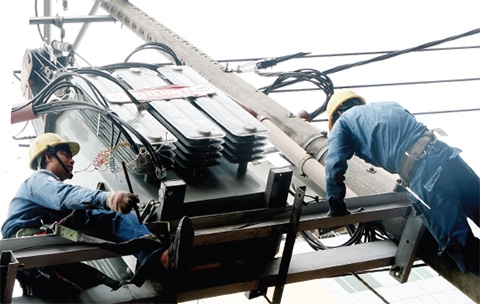Electricity plants face cutbacks in coal imports
Electricity plants face cutbacks in coal imports
Vietnam’s coal-fired power plants are bracing for tightened exports from Indonesia, the world’s top exporter of coal used by thermal power plants.

Vietnamese power generators are now concerned that Indonesia is tightening its coal exports in order to maintain the sustainability of supply amid the growing domestic demand as the government reduce reliance on oil-related fuels and the demand would rise from power plants and smelters.
“The 2013 regulations have it that low- and mid-calorific value coal will not be allowed to be exported from Indonesia. The coal will be used to boost the domestic power sector in the country,” Otto Riadia, economic counselor at Indonesia Embassy to India was quoted by local press last week.
K Rajagopal, CEO for thermal power at India’s Lanco Infratech Ltd, which runs a 1,200 megawatt power plant fuelled entirely by imported coal, was quoted by foreign media: “It’s a setback for power producers. This will discourage them from taking up projects based on imported coal.”
Tran Viet Ngai, chairman of the Vietnam Energy Association (VEA), said that the search for sufficient coal sources would also pose a headache for Vietnamese power generators. He said that Australia and Indonesia continued exporting to Vietnam, but both had not informed anything about if they could ensure coal supplies for Vietnam and for how long. Vietnam so far imported 9,570 tonnes of coal from Indonesia.
At present, Vietnamese thermal power generators are mostly using domestic coal to fuel their plants. They would, however, face supply shortage in the years to come because of the limited mining capacity of state-run Vinacomin, according to the Ministry of Industry and Trade (MoIT).
Previously, Nguyen Thanh Son, director of Song Hong Energy Company, said that China and Japan also sought coal supplies from Indonesia and Australia. Meanwhile, according to Son, China and Japan have competitive edges over Vietnam in importing coal, by virtue of long-term investment strategies, higher efficiencies and bigger ports. They are also able to pay higher prices.
Under Vietnam’s power development strategy until 2020, coal-fired power plants would still remain the most important source of power generation in Vietnam, taking up 48 per cent of the nation’s total generation capacity, or 256 billion kWh. Coal-fired power plants in Vietnam would estimatedly need 67.3 million tonnes of coal per year.
State-run PetroVietnam, for example, planned to put six coal-fired power plants into operation during 2012-2015 with the total designed capacity of 6,000MW, comprising Vung Ang 1 in central Ha Tinh province, Thai Binh 2 in northern Thai Binh province, two plants in central Quang Binh province, Long Phu 1 in southern Soc Trang province and the other in southern Hau Giang province.
Vietnam, a net coal exporter, would have to import nearly six million tonnes of the power generating fuel by 2015 to meet its demand as the domestic supply is declining, according to Vinacomin. The imported coal would be used as fuel for power plants in the country’s central and southern regions.
To meet the rising domestic demand, Vinacomin’s acting deputy director Vu Manh Hung said the Vietnamese government should timely approve the specific plan to mine the coal basin in the Red River Delta with the estimated reserve of roughly 210 billion tonnes.
vir




















